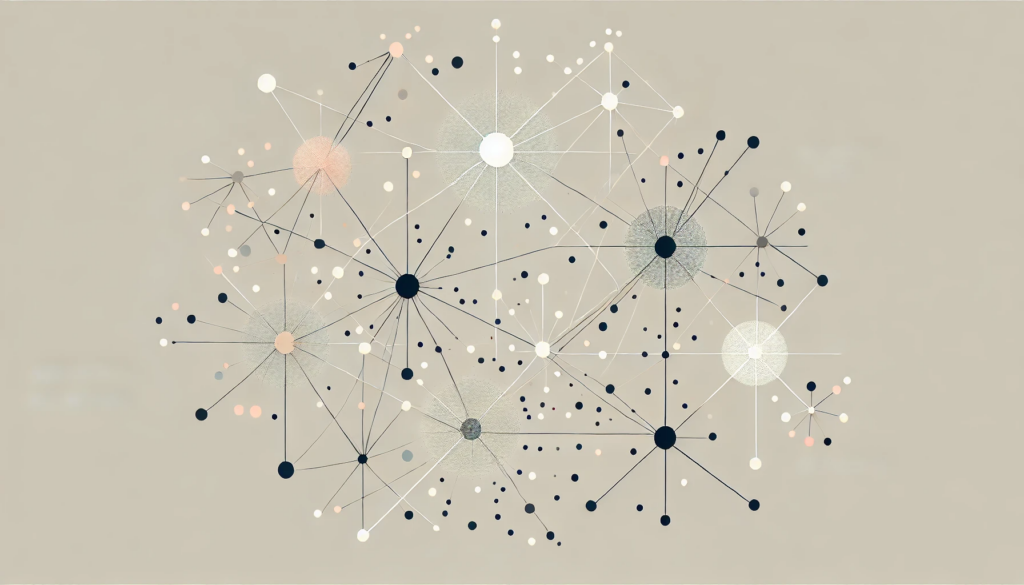
ChatGPT:
The Strength of Weak Ties by Mark Granovetter
📖 Introduction
Mark Granovetter’s The Strength of Weak Ties is a landmark study in sociology and network theory, highlighting how weak social connections—casual acquaintances or professional contacts—play a pivotal role in the dissemination of information and resources. This theory challenges traditional assumptions about the importance of close, emotionally intense relationships, or “strong ties.” Granovetter’s work has far-reaching implications across sociology, urban planning, economics, and the digital world.
This extended summary delves into Granovetter’s key ideas, the empirical evidence supporting his theory, and the wide-ranging applications of weak ties in various fields.
🌉 Core Thesis: What Are Weak Ties?
Granovetter distinguishes between strong ties and weak ties:
• Strong Ties: Relationships characterized by emotional closeness, frequent interaction, and trust (e.g., family and close friends).
• Weak Ties: Casual or infrequent interactions, such as acquaintances or distant colleagues.
Weak ties are valuable because they link individuals to new social circles. While strong ties create dense, tightly-knit groups with overlapping networks, weak ties serve as bridges connecting different clusters. These bridges enable the flow of novel information, which would not travel within a single network.
For instance, if everyone in your close circle shares the same knowledge or opportunities, you won’t access anything beyond that group. Weak ties, on the other hand, expand your access to external resources.
🧩 Key Findings
1. Weak Ties as Bridges
Granovetter introduces the concept of weak ties as bridges that connect different social groups. Without these ties, many social networks would remain isolated, reducing the flow of information and innovation.
2. Information Diffusion
Weak ties are instrumental in spreading new ideas and opportunities. Granovetter’s research showed that weak ties often provide access to unique job opportunities, events, or insights that strong ties may not know about.
3. Empirical Evidence from Job Searches
Granovetter’s most famous example comes from his studies of job seekers. He found that people are more likely to find jobs through weak ties than strong ones. Weak ties expose individuals to new opportunities by connecting them to different social circles.
🗺️ Applications of Weak Tie Theory
1. Sociology and Urban Planning
In urban studies, weak ties help individuals navigate large, complex communities. For instance, neighbors or casual acquaintances in a city often provide critical local knowledge or connections.
2. Business and Marketing
Weak ties are crucial in marketing strategies, especially in today’s interconnected world. Influencers with broad networks of weak ties can spread ideas, products, or messages quickly across diverse audiences.
3. Digital Networks
In the era of social media, weak ties are more prominent than ever. Platforms like LinkedIn and Twitter allow people to maintain weak connections globally, enabling collaboration, job searches, and idea-sharing at an unprecedented scale.
4. Organizational Behavior
Weak ties play a significant role in corporate environments, fostering innovation by connecting employees from different departments or organizations. This “boundary spanning” helps break silos and encourages fresh perspectives.
🔍 Balancing Strong and Weak Ties
Granovetter emphasizes that societies and individuals benefit from balancing both strong and weak ties:
• Strong Ties: Provide emotional support, trust, and close-knit cohesion.
• Weak Ties: Broaden access to information, foster innovation, and connect fragmented communities.
The coexistence of these two types of ties ensures stability, creativity, and progress.
📈 Implications in the Digital Era
The rise of digital platforms has amplified the importance of weak ties. Social media platforms like LinkedIn, Facebook, and Twitter have created vast networks of weak connections, enabling users to tap into global opportunities. These platforms highlight how weak ties drive influence, collaboration, and information-sharing.
For example, LinkedIn users frequently secure jobs or partnerships through weak connections—contacts they interact with infrequently but who provide access to new industries or regions.
🌟 Legacy of the Theory
Granovetter’s work has had a profound and enduring impact across disciplines:
1. Sociology: It reshaped the understanding of social networks and the flow of information.
2. Economics: Influenced labor market theories by highlighting how information spreads through networks.
3. Urban Studies: Provided insights into community dynamics and social cohesion in cities.
4. Digital Sociology: Anticipated the role of weak ties in the age of social media.
Even decades after its publication, The Strength of Weak Ties remains a cornerstone of network theory, inspiring research in diverse fields.
🌐 Conclusion
Mark Granovetter’s The Strength of Weak Ties is a profound exploration of how casual connections shape social, economic, and informational landscapes. By emphasizing the importance of weak ties, Granovetter challenges traditional assumptions about strong relationships. Weak ties bridge gaps between isolated groups, driving innovation, spreading opportunities, and fostering societal cohesion.
The rise of digital platforms underscores the enduring relevance of Granovetter’s insights, making them essential for understanding modern networks. In essence, weak ties are the threads weaving diverse communities into a connected and innovative society.
Implications of Weak Ties in the Digital Era
Mark Granovetter’s theory of weak ties has gained even greater relevance in the digital age, where online platforms and social media networks have drastically reshaped the way people form and maintain connections. Here are the deeper implications of his theory in the context of digital networks:
1. Global Reach of Weak Ties
The internet has exponentially increased the scale of weak ties. Social media platforms like LinkedIn, Facebook, Instagram, and Twitter allow individuals to connect with people across the globe. These platforms provide a medium for creating and maintaining weak ties that span diverse industries, geographies, and social groups.
For example:
• A Twitter user might follow industry leaders or participate in global conversations through hashtags.
• LinkedIn professionals leverage weak ties to connect with recruiters or collaborate on international projects.
These interactions bring opportunities, insights, and resources that would be unavailable within close-knit local networks.
2. Enhanced Information Diffusion
Weak ties play a critical role in spreading information online. Viral trends, news, and memes often propagate through these connections. Platforms like Reddit, TikTok, and YouTube amplify this effect by allowing users to share content broadly, often reaching beyond immediate networks.
• Example: A professional shares a job opening on LinkedIn. Weak connections, who belong to other industries or locations, amplify this post by resharing it, exposing the opportunity to a wider audience.
This mechanism exemplifies how weak ties spread novel ideas, products, and trends across diverse groups in seconds.
3. Digital Marketing and Influencers
Digital marketing strategies rely heavily on weak ties. Influencers on platforms like Instagram and YouTube maintain large followings composed predominantly of weak ties. These followers are often casual acquaintances or distant admirers who trust the influencer’s recommendations, making weak ties a cornerstone of social commerce.
• Micro-Influencers: Influencers with small, niche audiences leverage weak ties to build authenticity and trust within specific communities.
Marketers value weak ties for their ability to quickly disseminate information across broad and diverse networks, fostering product awareness and adoption.
4. Online Collaboration and Innovation
Digital tools and platforms have transformed weak ties into engines of innovation. Platforms like Slack, GitHub, and Zoom enable remote teams to collaborate across geographical boundaries. These tools allow weak ties between professionals in different regions or industries to form, driving cross-disciplinary solutions.
• Example: Open-source projects on GitHub often involve contributors who are weakly connected. Despite this, they collaborate to produce groundbreaking software by pooling expertise from different fields.
Weak ties create a fertile ground for serendipitous interactions, where a chance connection sparks significant innovation or partnership.
5. Job Search and Networking
LinkedIn epitomizes Granovetter’s weak tie theory in the digital age. Professionals use the platform to maintain casual connections with former colleagues, distant acquaintances, and industry leaders. These connections often provide job referrals or mentorship opportunities.
Studies have shown that LinkedIn users often secure employment through weak ties rather than close friends, aligning with Granovetter’s original findings.
6. Diversity of Perspectives
Digital networks allow weak ties to connect individuals with people from vastly different backgrounds, ideologies, and cultures. This diversity fosters a greater exchange of ideas and reduces the echo chamber effect often seen within close networks.
• Example: Engaging in global forums, communities like Reddit or Quora, and niche interest groups fosters interaction with individuals holding diverse opinions, enhancing creativity and problem-solving.
7. Scalability of Weak Ties
Maintaining weak ties in the physical world often requires deliberate effort, such as occasional calls or meetings. In the digital world, platforms like Facebook or Instagram allow users to sustain these ties passively through likes, comments, and shared content. This scalability makes it possible to manage hundreds or thousands of weak connections effortlessly.
8. Disrupting Traditional Power Structures
The accessibility of weak ties in digital spaces disrupts traditional hierarchies and power dynamics. Digital platforms democratize opportunities by enabling marginalized groups to connect directly with influential networks. For example, grassroots campaigns on platforms like GoFundMe or Change.org leverage weak ties to gain traction and visibility.
9. Challenges in the Digital Era
While weak ties provide immense opportunities, they also introduce challenges:
• Misinformation: Weak ties can rapidly spread false information or harmful content. For example, conspiracy theories often gain traction through loosely connected online groups.
• Superficial Connections: Digital weak ties may lack the depth required for meaningful collaboration or trust-building, limiting their effectiveness in certain contexts.
Balancing the advantages of weak ties with efforts to mitigate these risks is essential in the digital era.
Conclusion
Granovetter’s weak tie theory offers a profound lens for understanding the dynamics of the digital age. Platforms like LinkedIn, Facebook, and Reddit exemplify the value of weak ties in creating opportunities, spreading information, and fostering innovation. However, leveraging these connections effectively requires careful navigation of challenges like misinformation and superficiality. In sum, weak ties in the digital era serve as a powerful tool for global connectivity, innovation, and collaboration, shaping the modern social and professional landscape.

FAQs
1. What are weak ties according to Mark Granovetter?
Weak ties are casual or less emotionally intense connections, such as acquaintances, coworkers, or distant colleagues. Unlike strong ties (close friends or family), weak ties link individuals to new social networks and provide access to novel information and opportunities.
2. Why are weak ties important?
Weak ties act as bridges between isolated social groups, enabling the flow of fresh ideas, job opportunities, and resources. They play a critical role in expanding one’s social reach and are particularly valuable in spreading information across diverse networks.
3. How do weak ties compare to strong ties?
• Strong Ties: Close relationships that provide emotional support and trust but often circulate redundant information within the same group.
• Weak Ties: Casual connections that link diverse groups, offering access to new opportunities and perspectives.
Both types of ties are essential, but weak ties are particularly powerful in networking and innovation.
4. What is an example of weak ties in action?
Granovetter’s research found that people often secure jobs through acquaintances rather than close friends. Acquaintances, or weak ties, introduce individuals to opportunities that their immediate circle might not know about.
5. How do weak ties function in the digital age?
Digital platforms like LinkedIn, Facebook, and Twitter enable individuals to maintain and utilize weak ties on a global scale. These platforms amplify the power of weak ties by allowing users to connect with people across industries, cultures, and geographies, facilitating collaboration, job searches, and information-sharing.
6. What role do weak ties play in social media marketing?
Influencers leverage weak ties to promote products and ideas to broad audiences. Their followers, who are typically casual connections, trust their recommendations and amplify their reach by sharing content across diverse networks.
7. How do weak ties drive innovation?
Weak ties connect individuals from different disciplines or organizations, fostering cross-pollination of ideas. In professional settings, weak ties often break silos, enabling collaborative problem-solving and creativity.
8. What challenges are associated with weak ties in the digital era?
• Misinformation: Weak ties can rapidly spread false or harmful information.
• Superficial Connections: Digital weak ties may lack depth, leading to less meaningful interactions or limited trust.
9. Can weak ties replace strong ties?
No, weak ties complement strong ties rather than replacing them. Strong ties provide emotional support and stability, while weak ties offer access to broader opportunities and new ideas. Both are essential for a balanced and effective social network.
10. How has Granovetter’s theory influenced modern fields?
Granovetter’s theory has shaped research and practices in sociology, marketing, urban planning, organizational behavior, and digital networking. It highlights the importance of diverse social connections in fostering societal and individual success.

